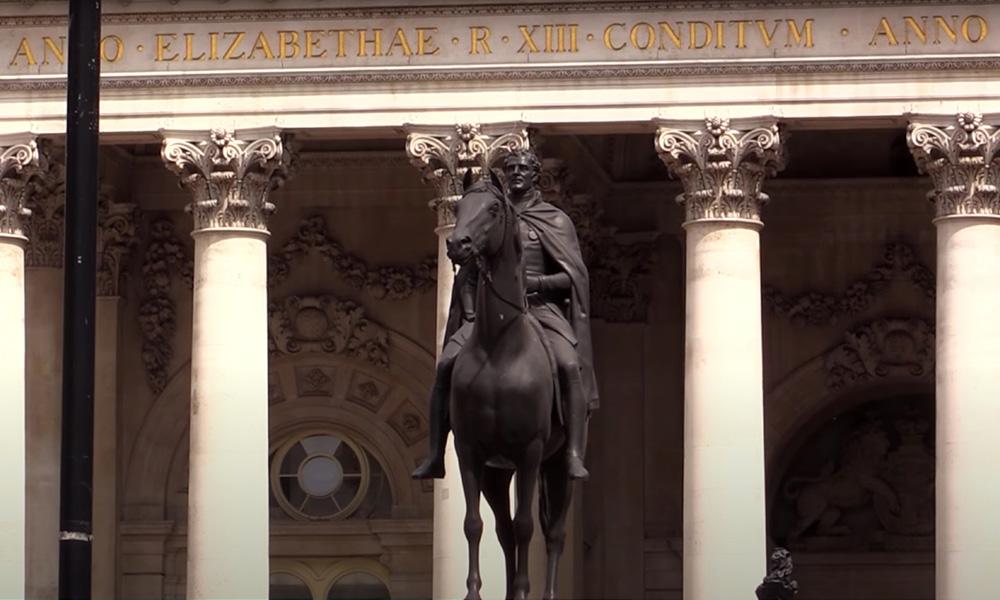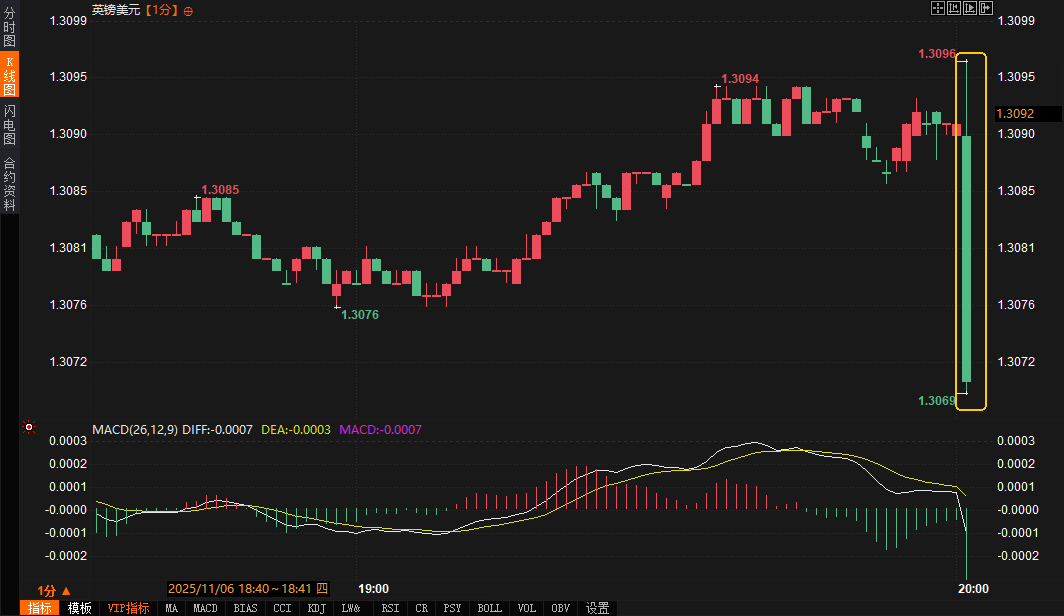The Bank of England's decision sent the pound sterling plummeting! The FTSE 100 led the decline, with traders closely watching Bailey's "trump card."
2025-11-06 20:13:36

The current market environment remains constrained by multiple factors. Entering November, major global economies are generally facing the dual pressures of high inflation and sluggish growth. The Bank of England's decision reflects not only the domestic economic situation but is also indirectly influenced by fluctuations in international energy prices and geopolitical factors. The UK Consumer Price Index (CPI) remained flat at 3.8% in September, the highest among the G7 countries, but signs of a cooling job market emerged: fewer job vacancies and stagnant job growth provided a basis for the dovish stance within the Monetary Policy Committee. Prior to the decision, market pricing indicated about a one-third probability of a 25 basis point rate cut, partly due to recent slowdowns in wage growth and signs of weak demand. However, the Bank of England also noted that inflation could remain high if administrative prices rise again or corporate profit margins expand, making the decision to maintain interest rates more cautious. Overall, this hold-up move marks the first pause in the Bank of England's gradual easing cycle, which began in August 2024, highlighting its difficult balance between curbing inflation and supporting the economy.
Following the announcement of the resolution, the market reacted immediately, revealing a clear risk-averse sentiment. Just after 12:00 London time, the pound fell 24 points against the dollar, hitting a low of 1.3071, a drop of approximately 0.2% from its pre-resolution high. This volatility stemmed primarily from the more hawkish turn in the vote than expected – four committee members supported an immediate 25 basis point rate cut, higher than the three predicted in a Reuters poll. Simultaneously, the UK FTSE 100 index fell 0.23%, led by the financial sector, with energy and pharmaceutical stocks also experiencing sell-offs. The bond market was equally sensitive, with the yield on 2-year UK government bonds falling 2 basis points to 3.79%, reflecting rising investor expectations for future easing policies. In contrast, US stock futures saw limited volatility during the Asian and European sessions, with Dow Jones futures slightly down 0.1%, indicating weaker transatlantic market correlation, although some safe-haven funds had flowed into gold and Japanese yen assets.

Trader sentiment fluctuated significantly before and after the decision was announced. Prior to the announcement, the market was generally cautiously optimistic: most institutions expected a 70% probability of interest rates remaining unchanged, pointing to the fiscal tightening risks from the upcoming budget, which could delay a rate cut; retail investors, however, were more focused on employment data, with some traders believing that a dovish stance would prevail if the unemployment rate rose to 5%. For example, a forex analyst noted before the decision: "The Bank of England faces a difficult choice; the market is only pricing in a 30% probability of a rate cut, but flat inflation could be a turning point." This assessment is consistent with the Bank of England's August report, where the Monetary Policy Committee raised its 2025 economic growth forecast to 1.25%.
Following the data release, trader sentiment shifted rapidly. Institutional interpretations became more professional and restrained, focusing on the impact of the vote's divergence on the policy path. One macroeconomic data tracking agency noted: "The Monetary Policy Committee maintained interest rates 5-4. The hawkish bias initially boosted the pound, but Bailey's statement that 'more evidence is needed' may strengthen expectations of a December rate cut. " Another institution believes that the emphasis on weak demand risks in the monetary policy report—such as household savings failing to translate into consumption—has downgraded the upside risks to inflation from "significant" to "balanced," consistent with the August forecast's downward revision of the one-year inflation expectation from 2.7% to 2.5%, logically supporting gradual easing. Retail investors reacted more emotionally, with many expressing disappointment. One retail trader said, "I thought a rate cut would follow weak employment data; it seems we'll have to wait a bit longer at 4%." Overall, trader sentiment shifted from "expectations maintained but hoping for surprises" to "maintaining confirmation but with increased divergence," reflecting investors' high sensitivity to policy uncertainty. Overall, the market consensus is that although no action was taken in this decision, the interest rate path has been anchored at 3.9% in the fourth quarter of 2025 and 3.5% in 2026, which is largely consistent with the August forecast, while leaving room for adjustment for what Bailey called a "fair description".
From a fundamental perspective, this decision is particularly crucial in anchoring expectations for interest rate cuts. Bailey reiterated, "We still believe interest rates are on a gradual downward path, but we need to ensure inflation returns to the 2% mark." This statement is more dovish than the "gradual caution" of September, and combined with the Monetary Policy Committee's assessment of economic activity—UK GDP is below potential, with Q3 2025 growth at only 0.2% quarter-on-quarter, lower than the 0.4% forecast in September—it shows the Monetary Policy Committee has prioritized downside risks to demand. Private sector wage growth expectations were lowered to 3.5% in Q4 2025, down from the 3.75% forecast in August, while the unemployment rate forecast was raised to 5.0%. These adjustments logically stem from the dual signals of a cooling labor market and weakening inflation persistence. In contrast, when inflation surged to 11% in October 2022, the Bank of England was forced to aggressively raise interest rates to their peak; now, the assessment that inflation has peaked confirms a shift in policy from tightening to observation, similar to the "pause-assessment" model following the first rate cut in August 2024. However, potential upside risks remain: if administrative prices (such as energy tariffs) push up costs again, or if corporate profit margins widen, inflation could veer off course. This echoes the logic of the Federal Reserve's recent stance of maintaining "higher and longer" interest rates; while not directly linked, it strengthens expectations of policy coordination among global central banks.
Shifts in trader sentiment further amplified the transmission of these fundamental signals. Prior to the decision, derivatives pricing indicated relatively conservative bets on rate cuts, with approximately a 60% probability pointing to action in December; after the announcement, this probability quickly rose to over 70%, and the implied volatility of the pound briefly increased by 15%. Institutional analysis largely attributed this to Bailey's statement that "waiting for further evidence is worthwhile"—this not only responded to the recent decline in expected inflation and employment data for October and November but also indirectly mitigated the drag on growth that the budget might cause through increased taxes. At the retail level, sentiment shifted from optimism to a wait-and-see approach. One trader summarized: "The 5-4 vote, coupled with Bailey's wavering tone—the pound is weak in the short term, but in the long term, the door to rate cuts has been opened." This divergent sentiment fueled immediate market volatility: although the pound rebounded from its lows, it remained largely constrained around the 1.31 level, reflecting concerns about fiscal austerity. From a technical perspective, the GBP/USD daily chart formed a short-term lower shadow after the decision, suggesting buying interest at lower levels. However, the Relative Strength Index (RSI) has fallen from overbought territory to 55, indicating neutral momentum. Historically, similar to the August 2024 rate cut, the pound rebounded from 1.27 to 1.32, logically stemming from the realization of expectations. The current divergence under the current interest rate stance is similar to the "hawkish pause" in November 2023, when the exchange rate fluctuated between 1.25 and 1.28 for about three weeks.
Looking ahead, the Bank of England's gradual policy stance will be the main theme in the market. If data from October and November continue to show an economic slowdown, the probability of an interest rate cut at the Monetary Policy Committee meeting in mid-December will increase further, with the benchmark interest rate potentially entering a new range of 3.75%, broadly consistent with the market's expected interest rate path of 3.5% by the end of 2026. In the long term, inflation stabilizing at 2.0%-2.1% in 2027-2028 and economic growth rebounding to 1.6%-1.8% will mark the UK economy's transition from "below potential" to a balanced recovery. However, external variables cannot be ignored: the energy premium transmission from the Russia-Ukraine conflict and the chain reaction of weak global demand could amplify downside risks. Compared to historical cycles, this decision is closer to the "soft landing" model of the post-pandemic recovery after 2020—not a radical shift, but a data-driven fine-tuning. Investors should remain vigilant and pay attention to fiscal signals following the budget to grasp the shift from short-term volatility to a medium- to long-term easing logic. Overall, the Bank of England's cautious stance has injected stability into the market and will help the UK economy steadily advance amidst uncertainty.
- Risk Warning and Disclaimer
- The market involves risk, and trading may not be suitable for all investors. This article is for reference only and does not constitute personal investment advice, nor does it take into account certain users’ specific investment objectives, financial situation, or other needs. Any investment decisions made based on this information are at your own risk.





















